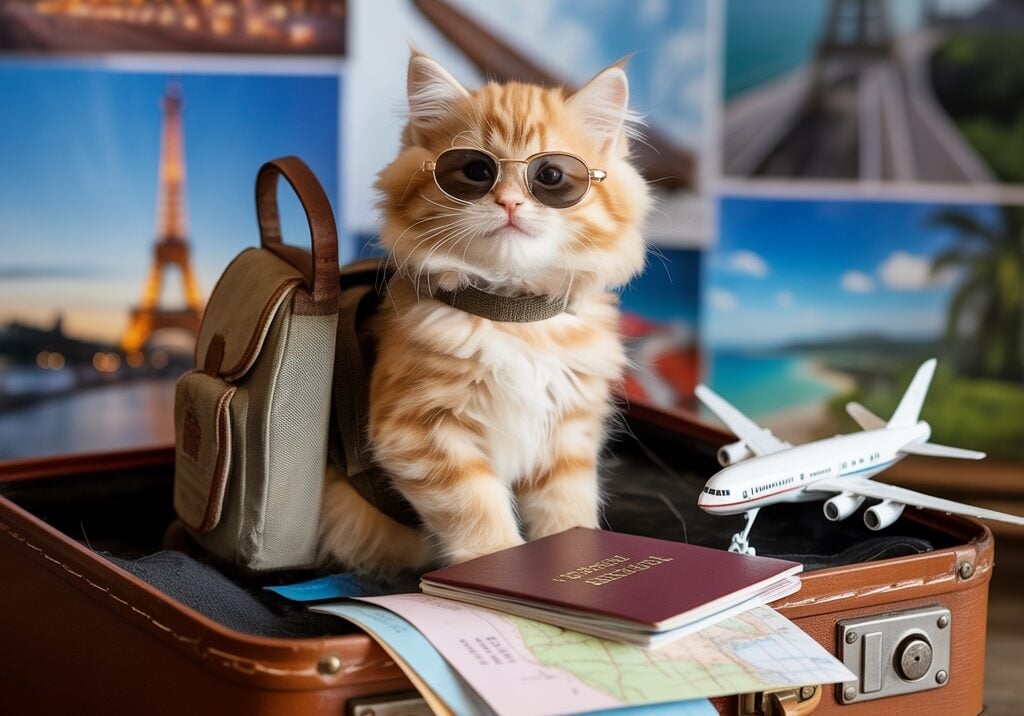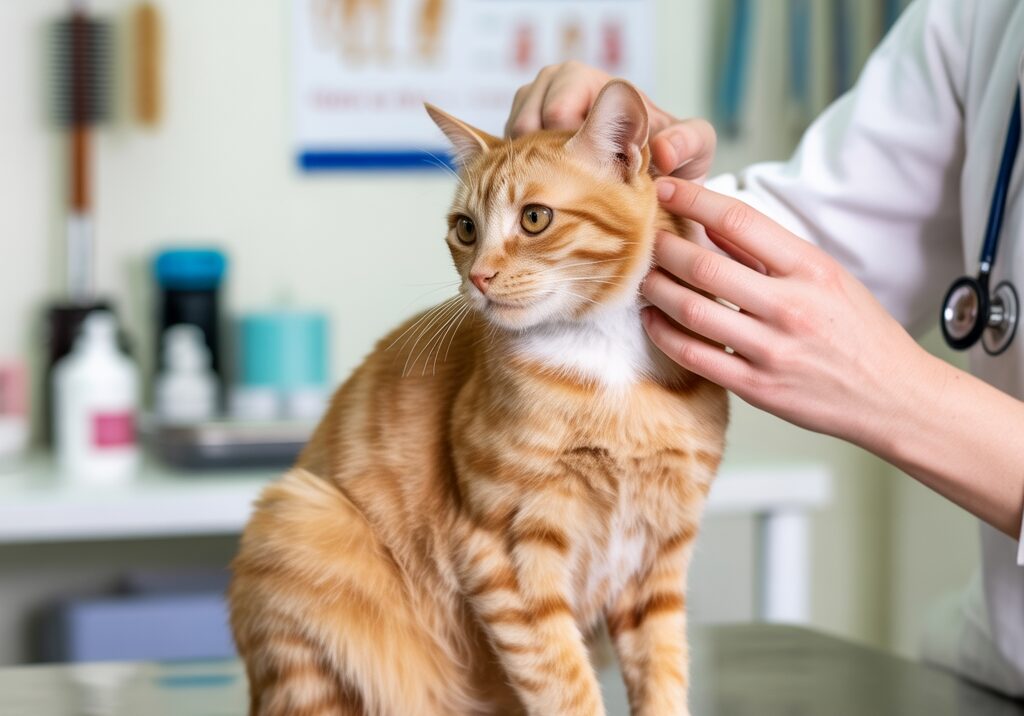Traveling with cats can be a daunting task, but with the right preparation, it can be a stress-free experience for both you and your feline companion.
Understanding your cat’s travel temperament is crucial. Some cats are naturally more adventurous, while others may need extra care and attention to make the journey comfortable.
To ensure a smooth trip, it’s essential to prepare your cat for travel by following cat travel tips from experts, which include navigating air travel and finding cat-friendly accommodations.
Key Takeaways
- Understand your cat’s travel temperament to prepare accordingly.
- Follow expert cat travel tips for a stress-free journey.
- Research and book cat-friendly accommodations in advance.
- Prepare your cat for air travel by understanding airline pet policies.
- Keep your cat’s comfort and safety as the top priority during travel.
Understanding Your Cat’s Travel Temperament
Before you start planning your trip with your feline friend, it’s crucial to understand their temperament when it comes to travel. Traveling with cats can be challenging, but with the right preparation, you can make the journey smoother for both you and your pet.
Assessing Your Cat’s Personality and Travel Readiness
Evaluating your cat’s personality is the first step in determining their travel readiness. Some cats are naturally more adventurous, while others may be more anxious or stressed by new environments. Consider your cat’s past experiences and reactions to new situations to gauge their travel readiness.
Recognizing Signs of Travel Anxiety in Cats
Cats often exhibit specific behaviors when they’re anxious or stressed about travel, such as meowing, pacing, or hiding. Recognizing these signs early can help you take proactive steps to mitigate their stress. Keeping a calm and patient demeanor can also help reassure your cat during travel.
Building Positive Travel Associations Through Training
Training your cat to associate travel with positive experiences can significantly reduce their travel anxiety. Start by introducing your cat to their carrier and gradually acclimating them to car rides or other travel environments. Rewarding calm behavior with treats and praise can help build positive associations.
By understanding your cat’s travel temperament and taking steps to prepare them, you can make your journey together much more enjoyable and stress-free.
Pre-Travel Veterinary Considerations
Before embarking on a journey with your feline companion, it’s essential to consider several veterinary factors. Ensuring your cat’s health and safety while traveling requires careful planning and preparation.
Required Vaccinations and Health Certificates for Domestic and International Travel
Different regions have specific requirements for cat vaccinations and health certificates. For domestic travel, ensure your cat is up-to-date on routine vaccinations. For international travel, research the destination country’s requirements, which may include additional vaccinations and a health certificate issued by a licensed veterinarian within a specified timeframe before travel.
Microchipping, ID Tags, and Digital Identification Options
Microchipping your cat provides a permanent form of identification. Ensure your cat’s ID tags are updated with your contact information. Consider digital identification options, such as a pet passport or a digital record of your cat’s health information and identification details.
| Identification Method | Description | Benefits |
|---|---|---|
| Microchipping | Permanent identification implanted under the skin | Ensures identification if collar and tag are lost |
| ID Tags | Collars with tags containing owner’s contact information | Quick identification by visual inspection |
| Digital Identification | Electronic records of pet’s identification and health | Accessible anywhere, providing vital information |
Medication Options and Natural Remedies for Anxious Travelers
For cats experiencing travel anxiety, consult with your veterinarian about medication options or natural remedies. Pheromone products, calming treats, and gradual exposure to the carrier can help reduce your cat’s stress.
Pre-Travel Health Checkup Essentials
A pre-travel health checkup is crucial to identify any underlying health issues that could impact your cat’s travel. Discuss your travel plans with your veterinarian to get personalized advice and ensure your cat is healthy enough for travel.
By addressing these pre-travel veterinary considerations, you can help ensure a safe and enjoyable journey for both you and your feline companion.
Selecting the Perfect Travel Carrier
The journey begins with the right carrier; selecting a suitable travel carrier is vital for your cat’s travel experience. A travel carrier is more than just a container; it’s a safe space for your cat during travel.
Airline-Approved Carrier Features and Regulations
When choosing a carrier, it’s essential to consider airline-approved features and regulations. Most airlines have specific requirements for the size, material, and ventilation of cat carriers. Ensure the carrier you choose complies with these regulations to avoid any last-minute issues.
- Check the airline’s website for the most up-to-date information on carrier requirements.
- Consider carriers with sturdy construction and secure latches.
Size, Ventilation, and Comfort Considerations
The size of the carrier is crucial for your cat’s comfort. It should be large enough for your cat to stand, turn around, and lie down comfortably. Proper ventilation is also vital to prevent overheating and ensure a steady supply of fresh air.
“A well-ventilated carrier is not just a comfort; it’s a necessity for safe travel.”
Hard-Sided vs. Soft-Sided Carriers: Pros and Cons
Both hard-sided and soft-sided carriers have their advantages and disadvantages. Hard-sided carriers offer more protection and are generally easier to clean, while soft-sided carriers are more portable and can be easier to store.
| Carrier Type | Pros | Cons |
|---|---|---|
| Hard-Sided | More protection, easier to clean | Less portable, heavier |
| Soft-Sided | More portable, easier to store | Less protection, harder to clean |
Acclimating Your Cat to Their Carrier: A Step-by-Step Guide
Acclimating your cat to the carrier is a process that requires patience. Start by placing your cat’s favorite treats or toys inside the carrier to encourage exploration.
- Place the carrier in a common area to help your cat get used to its presence.
- Encourage your cat to enter the carrier voluntarily by using treats.
- Gradually increase the time your cat spends in the carrier.
By following these steps and considering the key factors in choosing a travel carrier, you can ensure a more comfortable and stress-free travel experience for your cat.
Jet-Setting with Whiskers: Tips for Stress-Free Cat Travel
When traveling with your cat, being prepared with the right essentials can make all the difference in ensuring a smooth and enjoyable trip. A stress-free journey for your feline companion begins with understanding their needs and packing accordingly.
Essential Items for Your Cat’s Travel Kit
A well-stocked cat travel kit is crucial for a comfortable journey. This kit should include your cat’s favorite food, a water bottle or bowl, and any prescribed medication. Don’t forget to pack a portable litter box and litter, as well as a few familiar toys to keep your cat entertained.
- A sturdy, airline-approved carrier
- Comfortable bedding or a familiar blanket
- Your cat’s identification and medical records
- A first-aid kit tailored to your cat’s needs
Food, Water, and Feeding Strategies During Transit
Maintaining your cat’s regular feeding schedule can help reduce travel stress. Consider a portable feeding system that allows for easy meal times. Keeping your cat hydrated is also crucial; use a spill-proof water container to prevent accidents.
For cats that get anxious or refuse to eat during travel, consult with your veterinarian about the best feeding strategies or consider a calming aid to make mealtime less stressful.
Comfort Items That Reduce Anxiety and Create Familiarity
Comfort items such as a familiar toy or blanket can provide a sense of security and comfort to your cat during the journey. These items can help reduce anxiety by creating a familiar environment, even in unfamiliar surroundings.
Documentation and Digital Records to Keep Handy
Ensure you have all necessary documentation and digital records easily accessible. This includes your cat’s health certificates, vaccination records, and any relevant medical information. Having these documents readily available can be invaluable in case of an emergency.
By focusing on these key areas and being thoroughly prepared, you can significantly reduce the stress associated with traveling with your cat, making the experience more enjoyable for both you and your feline friend.
Car Travel Strategies for Feline Companions
Ensuring your cat’s safety and comfort during car travel involves a combination of preparation and the right travel accessories. Whether you’re embarking on a short drive or a long road trip, having a well-planned strategy can make a significant difference in your cat’s travel experience.
Securing the Carrier in Your Vehicle for Maximum Safety
One of the most critical aspects of car travel with cats is securing their carrier to prevent it from shifting or tipping over during transit. You can achieve this by placing the carrier in the back seat and using a seatbelt to hold it in place or by positioning it in a stable area of the vehicle where it won’t be easily moved.
Planning Rest Stops and Breaks for Long Road Trips
For longer journeys, planning regular rest stops is essential. These breaks allow your cat to stretch, move around, and relieve themselves. Look for pet-friendly stops along your route where your cat can safely exit their carrier and get some exercise.
Some key considerations for rest stops include:
- Choosing quiet, low-stress locations to minimize your cat’s anxiety.
- Keeping your cat on a leash or in a secure, escape-proof area to prevent them from running off.
- Offering your cat water and a chance to eat if it’s time for a meal.
Managing Car Sickness and Motion Sensitivity
Some cats experience car sickness or motion sensitivity, which can lead to discomfort, vomiting, or anxiety during travel. To mitigate these issues, consider the following strategies:
- Consult with your veterinarian about potential medications or natural remedies that can help alleviate car sickness.
- Keep the car well-ventilated to reduce the likelihood of your cat feeling nauseous.
- Avoid feeding your cat a large meal immediately before traveling.
Creating a Cat-Friendly Environment in Your Vehicle
Making your vehicle cat-friendly can significantly enhance your cat’s travel experience. This can involve:
- Placing a familiar blanket or toy in the carrier to provide comfort.
- Maintaining a comfortable temperature within the vehicle.
- Minimizing noise levels or playing calming music to create a soothing atmosphere.
By implementing these car travel strategies, you can help ensure a safe, comfortable, and stress-free journey for your feline companion.
Navigating Air Travel with Your Cat
Air travel with cats can be a daunting task, but with the right preparation, it can be a stress-free experience for both you and your feline companion. Understanding the various aspects of air travel and how they impact your cat is crucial for a smooth journey.
Cabin vs. Cargo Considerations: Making the Right Choice
Deciding whether your cat should travel in the cabin or as cargo depends on several factors, including your cat’s size, temperament, and the airline’s pet travel policies. Smaller cats that fit in approved carriers under the seat in front of you can travel in the cabin, while larger cats may need to travel as cargo. It’s essential to weigh the pros and cons of each option and choose what’s best for your cat.
“The decision to travel with your cat in the cabin or as cargo should be based on what’s safest and most comfortable for your pet,” says Dr. Jane Smith, a veterinarian with experience in pet travel. “Consider your cat’s size, health, and temperament when making this decision.”
Airline-Specific Pet Policies and Reservation Requirements
Each airline has its own set of pet travel policies and requirements. Some airlines allow cats in the cabin, while others have specific cargo travel procedures. It’s vital to research and understand these policies before booking your flight. Many airlines also require pet reservations in advance, so be sure to plan accordingly.
- Check the airline’s website for pet travel policies.
- Contact the airline directly to make a pet reservation.
- Understand any additional fees associated with pet travel.
Airport Security Procedures with Cats: What to Expect
Navigating airport security with your cat can be challenging, but being prepared can help. You’ll need to remove your cat from their carrier and pass through security screening while holding them. It’s a good idea to practice this process before your trip to minimize stress.
In-Flight Care Tips and Communication with Flight Attendants
Once on board, ensuring your cat’s comfort and safety is paramount. Keep your cat’s carrier under the seat in front of you and follow the airline’s in-flight pet care instructions. Communicating with flight attendants about your cat’s needs can also help ensure a smooth flight.
Managing Layovers and Connecting Flights
For travelers with layovers or connecting flights, managing your cat’s travel becomes even more complex. Choose flights with shorter layovers when possible, and be prepared to navigate the airport quickly with your cat. Understanding the airline’s policies on layovers and connecting flights with pets is also crucial.
By carefully planning and preparing for air travel with your cat, you can minimize stress and ensure a safe and comfortable journey for both you and your feline companion.
Finding and Setting Up Cat-Friendly Accommodations
The key to a stress-free cat travel experience lies in selecting accommodations that welcome pets. When traveling with your feline companion, it’s essential to research and book a hotel that not only allows cats but also provides a comfortable environment for them.
Researching and Booking Truly Pet-Friendly Hotels
To ensure a smooth stay, it’s crucial to research hotels that are genuinely pet-friendly. Look for hotels that have specific policies and amenities for cats, such as pet beds, litter boxes, or even cat-sitting services. Websites like PetFriendlyTravel or BrilliantPet can provide valuable insights and reviews from other pet owners.
| Hotel Chain | Pet Policy | Amenities |
|---|---|---|
| Kimpton Hotels | Pets up to 75 lbs welcome | Pet beds, bowls, and treats |
| Marriott Hotels | Pets up to 50 lbs welcome | Pet-friendly rooms, pet-sitting services |
Setting Up a Comfortable Space in Your Temporary Home
Once you’ve booked your hotel, setting up a comfortable space for your cat is vital. Bring familiar items like their favorite bedding, toys, or even a blanket that smells like home. This can significantly reduce your cat’s stress and make them feel more at ease in the new environment.
Managing Litter Box Arrangements While Traveling
Managing litter box arrangements is a critical aspect of cat travel. When booking, check if the hotel provides litter boxes or if there are nearby pet supply stores. Always carry a portable litter box and some of your cat’s usual litter to minimize digestive upset.
Cat-Proofing Your Accommodation for Safety
Cat-proofing your hotel room is just as important as it is at home. Check for any hazardous materials or loose wires, secure toxic substances, and ensure windows are closed or have secure screens. This will help prevent accidents and ensure your cat’s safety.
By following these steps, you can create a comfortable and safe environment for your cat, making your travel experience enjoyable for both you and your feline companion.
Handling Travel Emergencies and Unexpected Situations
Even with meticulous planning, travel emergencies can occur, and knowing how to handle them is vital for cat owners. Whether you’re traveling by car or air, being prepared for the unexpected can make a significant difference in your cat’s safety and comfort.
Locating Emergency Veterinary Care at Your Destination
Before arriving at your destination, it’s crucial to research local veterinary clinics and emergency animal hospitals. Many hotels and travel websites provide lists of nearby veterinary services. Keeping a list of 24-hour emergency vet clinics and their contact information can be a lifesaver.
Creating an Emergency Action Plan for Escape Scenarios
If your cat escapes during travel, having a plan can help you react quickly. This includes knowing the local animal control services, having a recent photo of your cat for identification purposes, and being aware of the nearest shelters or animal welfare organizations.
| Emergency Situation | Action Plan |
|---|---|
| Cat escapes during travel | Contact local animal control, post flyers, check nearby shelters |
| Medical emergency | Locate nearest 24-hour veterinary clinic, contact hotel concierge for assistance |
| Travel delay or cancellation | Contact airline or travel provider, arrange for pet-friendly accommodations if necessary |
Dealing with Travel Delays and Cancellations
Travel delays and cancellations can be stressful for both you and your cat. Keeping your cat’s carrier and essentials easily accessible can help minimize stress. If a delay is announced, try to keep your cat calm with familiar comfort items or calming aids.
Managing Stress-Related Behaviors During Travel
Cats often exhibit stress-related behaviors during travel, such as meowing, pacing, or hiding. Using calming aids like pheromone diffusers or calming treats can help alleviate these behaviors. Ensuring your cat has a comfortable and secure space, like their carrier with familiar bedding, can also reduce stress.
By being prepared for travel emergencies and knowing how to manage stress-related behaviors, you can ensure a safer and more enjoyable journey for both you and your feline companion.
Conclusion: Creating Positive Travel Experiences for You and Your Cat
Traveling with your cat can be a rewarding experience when done correctly. By understanding your cat’s travel temperament and preparing them for the journey, you can create a stress-free cat travel experience.
With the right cat travel tips, you’ll be well on your way to enjoying many happy adventures with your feline companion. Whether you’re traveling by car or air, being aware of the various considerations involved can make all the difference in creating positive travel experiences.
By following the tips and strategies outlined in this article, you can ensure a smooth and enjoyable journey for both you and your cat. So pack your bags, grab your cat’s favorite toys, and get ready for a stress-free cat travel adventure.









